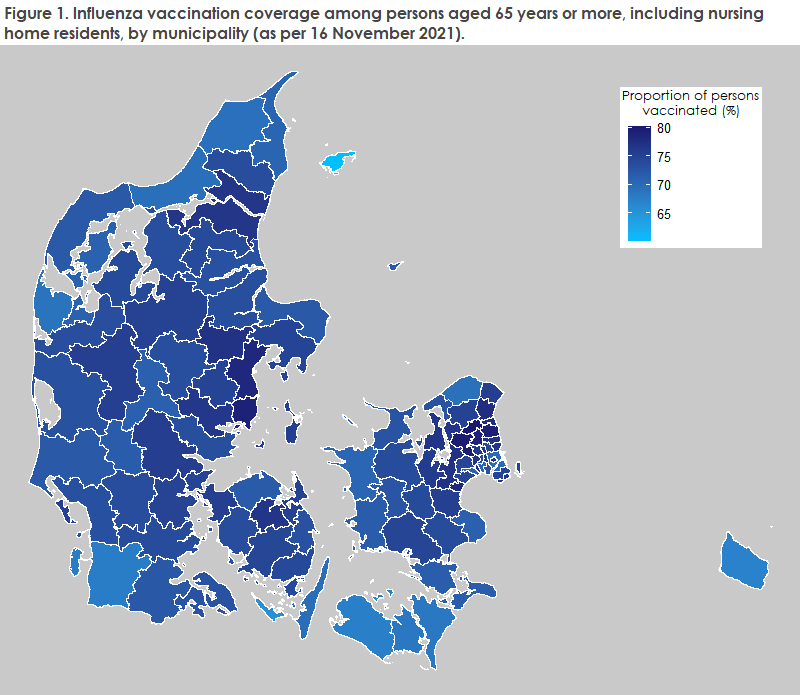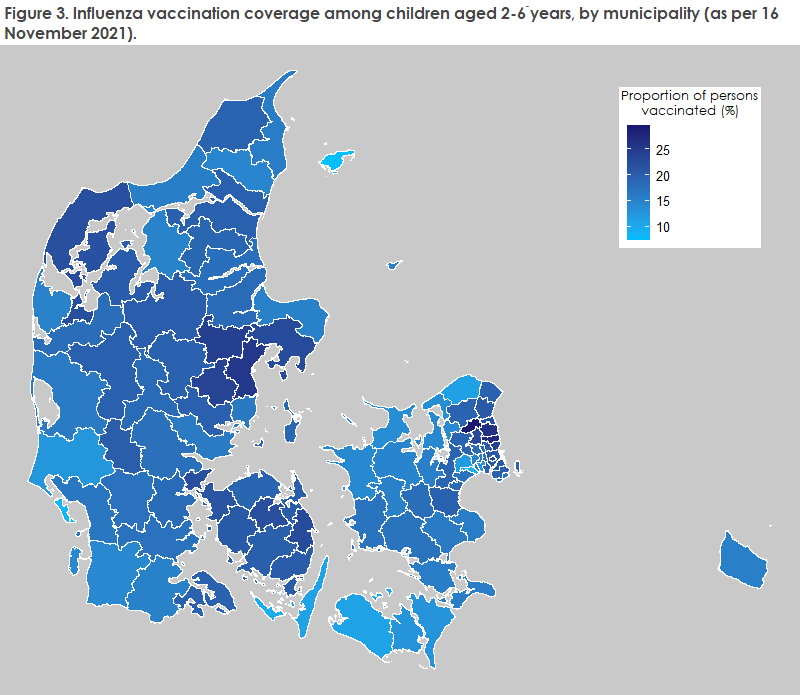No 46b - 2021
Preliminary update on the influenza vaccination coverage in the 2021/2022 season
Preliminary update on the influenza vaccination coverage in the 2021/2022 season
The annual vaccination campaign against seasonal influenza was launched on 1 October 2021 and free vaccination for risk groups has now been offered for about six weeks. The free influenza vaccination offer applies to individuals who have increased risk of developing severe disease and complications due to influenza infection, including, among others, nursing home residents, individuals aged 65 years or more, pregnant women in their 2nd or 3rd trimester and individuals below 65 years of age with underlying conditions. Furthermore, influenza vaccination is offered to healthcare and nursing staff, and as a novel initiative in the current season, also to children aged 2-6 years, EPI-NEWS no. 39/21.
The World Health Organization (WHO) recommends that a minimum of 75% of individuals aged 65 years or more receive influenza vaccination at the beginning of the annual influenza season. In Denmark, for many years, vaccination coverage has only reached approx. 50%. However, in the 2020/2021 season, coverage just reached the 75% objective for the first time ever.
In the coming winter period, a risk exists that a high prevalence of COVID-19 may coincide with a potential influenza epidemic, which may lead to an additionally increased load on the Danish healthcare system. Therefore, the objective for the 2021/2022 season is that 95% of individuals in the defined target groups receive influenza vaccination, with the exception of 2-6-year-old children for whom the objective is 85% as this group has been included in the vaccination program for the first time this season.
In this issue of EPI-NEWS, we provide a status quo on the current coverage of the ongoing influenza vaccination campaign for each of the risk groups, stated for Denmark as a whole and by municipality. The target groups are defined as outlined in the Executive Order.
Current update on influenza vaccination coverage in the 2021/2022 season
A total of 2.5 million influenza vaccine doses were acquired for use in this year’s vaccination campaign. At the end of week 45, 1.9 million influenza vaccines had been received from the vaccine manufacturers and supplied by Statens Serum Institut (SSI) to various Danish vaccine providers. The remaining vaccines will be supplied in the coming weeks.
In the course of the initial six weeks of the vaccination campaign (status quo as per 16 November 2021), approx. 1.5 million vaccines have been administered. The vaccination coverage in each target group is presented in Table 1.

The highest vaccination coverage is recorded among nursing home residents (83%), followed by individuals aged 82 years or more (76%) and individuals aged 65-81 years (74%).
In the combined group of individuals aged 65 years or more, including nursing home residents, coverage is now 74%, i.e. close to the objective of minimum 75% recommended by the WHO, but still at some distance from the national 95% objective.
In contrast, a somewhat lower vaccination coverage is recorded among the remaining target groups.
Among pregnant women in their 2nd or 3rd trimester, only 32% have currently accepted the vaccination offer. However, this figure should be interpreted taking into account that vaccination of pregnant women is often done at previously planned medical check-ups, why some delay is to be expected in this particular group.
Among healthcare and nursing staff, only 25% of the total target group has currently accepted the vaccination offer.
For individuals with underlying conditions who are offered influenza vaccination, coverage has currently only reached 21%.
The lowest vaccination coverage percentage is seen among children aged 2-6 years, among whom only 19% have currently been vaccinated (reported as the first of a total of two doses administered at a four-week interval).
Influenza vaccination coverage differences by municipality for the target groups
When studying the influenza vaccination coverage at the municipality level, it becomes clear that the coverage among nursing home residents is generally high across the 98 Danish municipalities. A total of 85 municipalities have achieved a coverage of 75% or more, and 45 municipalities have even reached a minimum coverage of 85%. The lowest vaccination coverage was recorded in Vallensbæk, Lolland and Solrød municipalities, where only 62%, 65% and 66%, respectively, of nursing home residents have been vaccinated.
The coverage among elderly persons who do not reside at a nursing home is also high across Denmark. Figure 1 shows the total coverage for nursing home residents and individuals aged 65 years or more, by municipality. Here, the vaccination coverage ranges from 60% in the Municipality of Læsø to 80% in the Municipality of Allerød.
However, considerably more pronounced geographical differences across Denmark are seen for the vaccination coverage among pregnant women in their 2nd or 3rd trimester (Figure 2), among children aged 2-6 years (Figure 3) and among healthcare and nursing staff (Figure 4). Here appears a clear picture of a generally higher vaccination coverage among citizens residing in larger cities and the municipalities located in the vicinity of a large city than in many of the municipalities located further away from the large cities. Furthermore, in the Greater Copenhagen Area, a generally higher vaccination coverage is seen among residents of several of the North Zeeland municipalities than among municipalities located to the west of Copenhagen.




Commentary
To counter potentially high loads on Danish healthcare due to a concurrent high number of persons infected by COVID-19 and influenza in the coming winter season, the objective is that as many target group individuals as possible receive influenza vaccination. Therefore, a record high number of vaccines was acquired for this year’s vaccination campaign.
Now, six weeks into the vaccination campaign, the SSI’s figures show that a high vaccination coverage has been achieved among the elderly part of the population, but also that influenza vaccinations are only progressing slowly among the younger target groups.
Additionally, the vaccination numbers reveal some marked geographical differences among municipalities. Thus, the overall pattern shows a somewhat higher coverage among the population residing in and around the larger cities than in non-urban areas, particularly in the younger target groups, e.g. pregnant women in their 2nd or 3rd trimester, children aged 2-6 years and, in particular, among healthcare and nursing staff.
Whereas a high vaccination coverage has already been achieved among the older target groups, a considerably stronger effort seems necessary to boost coverage in the younger target groups before the influenza season starts, which typically occurs in the course of December with high infection rates also in January, February and March. In several of the municipalities located outside of the large urban areas in particular, a need exists to accelerate influenza vaccination efforts.
(F.K. Lomholt, L.S. Vestergaard, Department of Infectious Disease Epidemiology and Prevention)